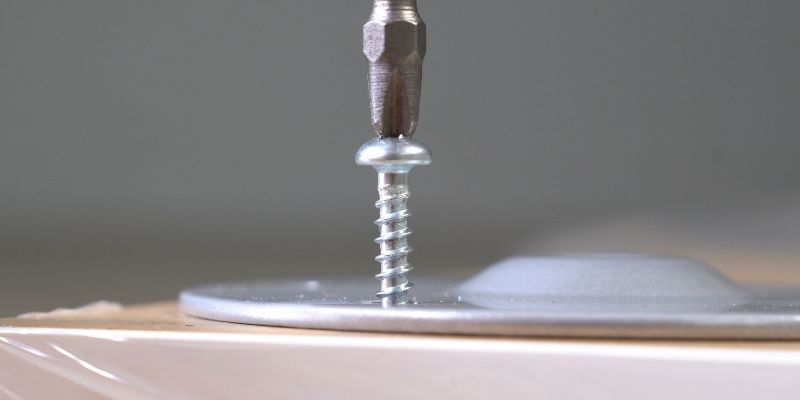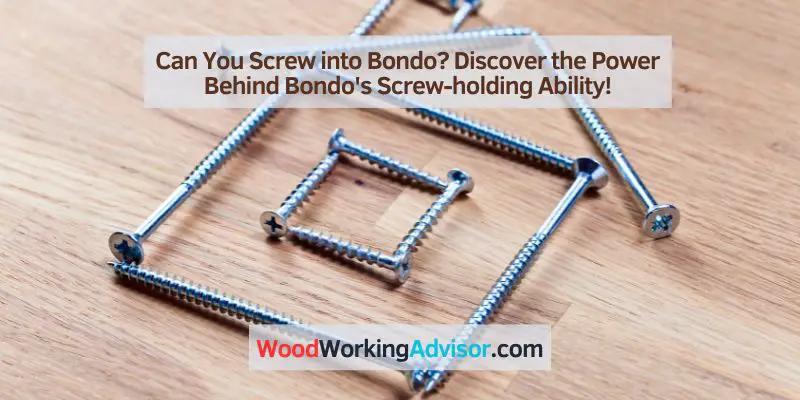Yes, you can screw into Bondo. Bondo is a versatile body filler that can be used to repair dents, scratches, and other imperfections in metal, wood, and other materials.
It dries to a hard, durable finish and can be sanded, shaped, and painted. When applying Bondo, it’s important to ensure that the surface is clean, dry, and free of any grease or oil. Once the Bondo has cured, you can then screw into it just like you would with any other solid material.
However, it’s worth noting that if you’re planning on screwing into Bondo, you should use screws with enough length and diameter to securely hold whatever you’re attaching.
Understanding Bondo
When it comes to fixing and restoring damaged surfaces, Bondo is a go-to solution for many DIY enthusiasts and professionals. This versatile material is commonly used in automotive repairs, boat restoration, and even household projects. But what exactly is Bondo? In this section, we’ll delve into the composition of Bondo, its applications, and whether you can confidently screw into it. Let’s explore!
What Is Bondo?
Bondo, technically known as polyester filler, is a type of automotive body filler that is widely used to repair dents, dings, and other imperfections. It is a two-part product consisting of a polyester resin and a hardener, which, when combined, create a chemical reaction that causes the mixture to cure and harden over time. This unique composition allows Bondo to be shaped and sanded easily, making it ideal for smoothing uneven surfaces and restoring damaged areas.
Composition Of Bondo
The composition of Bondo primarily consists of two essential components:
- Polyester Resin: The base of Bondo is made up of a polyester resin. This resin provides the material with its adhesive and filling properties, allowing it to adhere well to various surfaces, including metal, wood, and fiberglass.
- Hardener: The hardener, usually in the form of a liquid catalyst, is added to the polyester resin to initiate the curing process. When the hardener is mixed in the correct ratio, it triggers a chemical reaction that turns the mixture from a liquid into a solid, durable substance.
Together, these two components create a strong, lightweight, and waterproof compound that can withstand the demands of different repair and restoration projects.
Applications Of Bondo
Bondo finds extensive use in various applications, thanks to its versatility:
- Automotive Repairs: Bondo is commonly used in auto body repairs to fill in dents, scratches, or rusted areas. It can be easily shaped to match the contours of the vehicle and provides a smooth, seamless finish.

- Boat Restoration: Due to its water resistance and ability to withstand marine environments, Bondo is an excellent choice for repairing and restoring damaged areas on boats and other watercraft.
- Household Projects: Bondo can also be utilized for repairing damaged furniture, repairing holes in walls, and filling gaps or cracks in various surfaces around the house.
With its wide range of applications, Bondo has become a favorite tool in the DIY world, offering quick and effective solutions for both small and large-scale repairs.
So, now that we have a basic understanding of what Bondo is and its applications, let’s dive into the intriguing question: Can you screw into Bondo? Let’s find out in the next section.
The Screw-holding Ability Of Bondo
When it comes to repairing damaged surfaces, Bondo is often a popular choice. This versatile automotive body filler is known for its ability to fill in dents, cracks, and holes effectively. However, many people wonder if Bondo can also be used for screwing. In this section, we will explore the screw-holding ability of Bondo and discuss its benefits and limitations.
How Does Bondo Hold Screws?
While Bondo is primarily designed for filling and repairing purposes, it can indeed provide a decent grip for screws. The secret lies in its composition. Bondo is made up of a mixture of polyester resin and a filler material, typically a combination of talc, fiberglass, or other reinforcing agents. When hardened, Bondo becomes a strong and sturdy substance, capable of securely holding screws in place.
Benefits Of Using Bondo For Screwing
Using Bondo for screwing can offer several advantages, making it a viable option for certain situations. Here are some noteworthy benefits:
- Easy application: Bondo can be easily applied, providing a smooth and even surface for screwing. Its pliable texture and quick-drying formula facilitate a hassle-free application process.
- Strong hold: Once hardened, Bondo creates a firm and durable base, offering reliable support for screws. This ensures that the screws remain securely in place, even under significant stress.
- Versatility: Bondo is compatible with various materials, including wood, metal, and plastic. This versatility allows for its use in a wide range of applications, providing a reliable solution for different screwing needs.
Limitations Of Using Bondo For Screwing
While Bondo can be a suitable option for screwing in specific scenarios, it also has certain limitations that should be considered:
- Surface preparation: For Bondo to effectively hold screws, proper surface preparation is essential. The area should be clean, dry, and free from any paint, grease, or debris that may hinder the bonding process.
- Weight limitations: Bondo may not be suitable for heavy-duty applications or situations where significant weight or stress is expected. It is best suited for light to moderate loads.
- Longevity: Over time, the screw-holding ability of Bondo may deteriorate due to factors such as exposure to moisture, temperature changes, or structural movement. Regular inspection and maintenance may be necessary to ensure the integrity of the bond.
In conclusion, Bondo can indeed hold screws, providing a reliable solution for certain screwing needs. Its composition, ease of application, and versatility make it a viable option in many cases. However, proper surface preparation and an understanding of its limitations are crucial to ensure successful and long-lasting results.
Tips And Techniques For Screwing Into Bondo
When it comes to repair work and body filling, Bondo is a popular choice for many DIY enthusiasts and professionals alike. But can you screw into Bondo? The short answer is yes, you can. In fact, it can be quite handy to secure objects or aid in the repair process. However, there are some tips and techniques you should keep in mind to ensure a successful outcome. In this article, we will discuss the preparation and surface treatment, choosing the right type of Bondo, and the proper screwing technique to help you achieve the best results.
Preparation And Surface Treatment
Before you even think about screwing into Bondo, proper preparation and surface treatment are crucial to ensure a strong bond. Follow these steps:
- Clean the area: Begin by cleaning the surface where you plan to apply the Bondo. Remove any debris, dirt, or grease using a clean cloth or mild detergent.
- Sand the surface: Use sandpaper to roughen the area around the screw hole. This helps the Bondo adhere better and creates a rough surface for better grip.
- Apply a primer: Apply a thin layer of primer to the sanded surface. This helps the Bondo adhere to the surface and improves its overall strength.
Choosing The Right Type Of Bondo
When it comes to choosing the right type of Bondo, there are various options available in the market. Here are some popular choices:
| Type of Bondo | Best Use |
|---|---|
| Regular Bondo | For general purpose repairs and filling |
| High-Performance Bondo | For heavy-duty repairs and automotive use |
| Marine Bondo | For repairs in marine environments and water applications |
Choosing the right type of Bondo ensures the best results and durability for your specific project.
Proper Screwing Technique
Now that you have prepared the surface and chosen the right type of Bondo, it’s time to learn the proper screwing technique:
- Start small: Begin by screwing a small pilot hole into the Bondo with a drill bit that matches the screw size. This helps prevent cracking or damaging the Bondo.
- Screw in gently: Slowly and gently screw in the desired screw into the pilot hole, ensuring it is tightly secured without overtightening.
- Fill and finish: If necessary, apply an additional layer of Bondo over the screw head to blend it seamlessly with the surrounding surface. Sand the area smooth and finish with paint or other coating as needed.
By following these tips and techniques, you can effectively screw into Bondo without compromising the strength and integrity of the repair or project. Remember to always read the manufacturer’s instructions and take necessary safety precautions when working with Bondo or any other materials.

Frequently Asked Questions On Can You Screw Into Bondo
Can You Screw Into Bondo?
Yes, it is possible to screw into Bondo. However, it is important to note that Bondo is not as strong as other materials and may not provide the same level of support. It is recommended to use screws specifically designed for Bondo and to reinforce the area as needed for added strength.
How Do You Screw Into Bondo Without Cracking It?
To avoid cracking Bondo when screwing into it, it is crucial to take the proper precautions. Start by pre-drilling a pilot hole with a drill bit slightly smaller than the screw. This will help reduce the stress on the Bondo and prevent cracks.
It is also advisable to use screws specifically designed for use with Bondo and to reinforce the area as needed.
What Types Of Screws Work Best With Bondo?
When working with Bondo, it is important to choose the right screws for the job. Self-tapping screws are commonly used with Bondo due to their ability to create their own threads. Additionally, using screws with a larger diameter and coarse thread pitch can provide better grip and stability in the Bondo material.
Conclusion
Bondo proves to be a versatile solution for repairing damaged surfaces. Whether it is plastic, metal, or wood, Bondo offers a durable and reliable fix. However, it is important to note that while Bondo provides a strong bond for screws, it is not as sturdy as a solid material.
Ultimately, it is crucial to consider the material’s strength and condition before attempting to screw into Bondo. With care and proper application, Bondo can be an effective option for repairing and restoring various surfaces.



